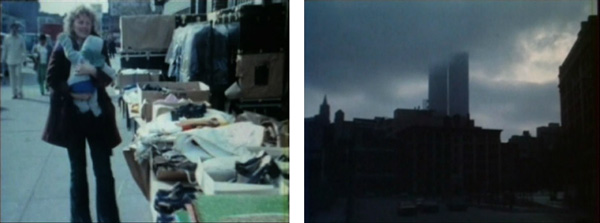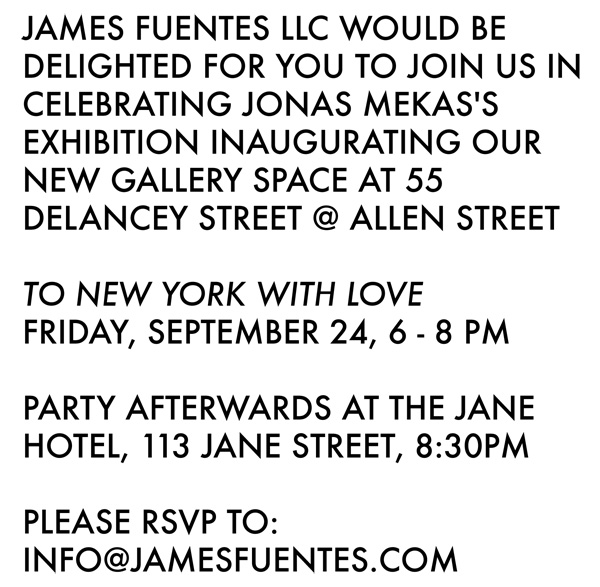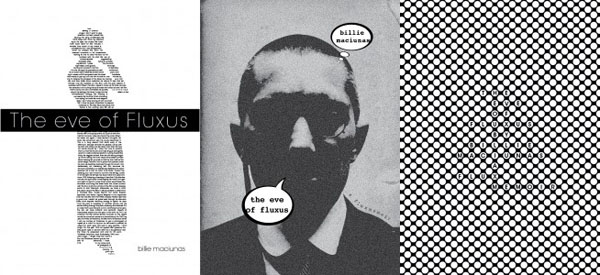A video-postcard from Sebastian.

Drop by the opening of my show, ‘To New York with Love,’ this Friday at James Fuentes Gallery!
September 24, 6- 8 p.m.
James Fuentes Gallery
55 Delancey Street (between Allen St. and Eldgridge St.)
New York, New York
Press Release
James Fuentes LLC is pleased to announce the inaugural exhibition of the gallery’s new location: To New York With Love, a solo exhibition by Jonas Mekas.
Two new works will be featured, Orchard Street (2010) & World Trade Center Haikus (2010). The artist writes about each piece:
“For three years, 1953-1956, Orchard Street was my home. I loved its crowded, bustling existence. The footage in this installation, with the exception of brief images of myself and my brother Adolfas, comes from the year 1975, many years later, but the street hadn’t yet changed during the interval of years since I had lived there, on 95 Orchard Street. Change came many years later… ”
“Looking through my finished and unfinished films, I was surprised how many glimpses of the World Trade Center I caught during my life in SoHo. I had a feeling I was Hokusai glimpsing Mount Fuji. Only that it was the World Trade Center. The WTC was an inseparable part of my and my family’s life during my SoHo period from 1975-1995. This installation is my love poem to it. My method in constructing this piece was simply to pull out images of the WTC from my original footage, while including some of the surrounding scenes. The result I felt came close, albeit indirectly, to what in poetry is known as the Haiku.”


September 18, 6-9 p.m.
Microscope Gallery
4 Charles Place
Brooklyn, NY 11221
Curated by Elle Burchill and Andrea Monti
Independent – from theory, accepted technique, prevailing politics, economic considerations, or even equipment; working with film, video, or sound; and based in New York, this describes the 11 very different artists we present in our inaugural month-long exhibition at MICROSCOPE Gallery, opening September 18th.
It is the spirit of innovation and uncompromising vision that we celebrate in Independence with works by emerging artists to those considered revolutionaries of their art forms. The artists, some of whom have been working for 2 and 3 generations, just do what they do, year-after-year without concern for current trends or schools of thought, and in spite of the inevitable obstacles that arise.
Such concentrated focus often leads to new possibilities and it is not surprising that each artist also works in other mediums including sculpture, collage, print and performance. Independence offers the rare chance to see the range of these artists works on display side-by-side.
Featuring works by: Peggy Ahwesh, Michel Auder, Agnes Bolt, Martha Colburn, Bradley Eros, Raul Vincent Enriquez, Glen Fogel, Takahiko Iimura, Tom Jarmusch, Jonas Mekas, Sebastian Mekas, and Anton Perich.

September 17, 6:30 – 9:30 p.m.
Emily Harvey Foundation
537 Broadway, 2nd Floor
New York, NY 10012
The Eve of Fluxus: A Fluxmemoir
Arbiter Press, Winter Park, Florida, 2010
A new book, The Eve of Fluxus: A Fluxmemoir, reveals the personal story behind the official history of George Maciunas, the founder of the 1960s avant-garde artists’ group Fluxus.
The original Fluxus group created one of the most radical practices of the 1960s. The open, inclusive activities spearheaded by George Maciunas brought many of the most renowned figures of the late 20th century into the Fluxus orbit, shaping the cultural and philosophical milieu of the Twenty-First Century.
The Eve of Fluxus: A Fluxmemoir reflects Billie Maciunas’ unique experience as researcher, poet, and witness through her marriage to George Maciunas to some of the most interesting art of our time. She is close friends with artists and scholars who have contributed to the book in the interest of unfolding the enigmatic personality of George Maciunas.
George Maciunas’ still under-explored project and life is soon to become more widely understood and appreciated as a result of the acquisition by The Museum of Modern Art in New York City of the largest collection of Fluxus and Maciunas design in the US, The Gilbert and Lila Silverman Collection.
Book proceeds will benefit the Atlantic Center for the Arts in New Smyrna Beach, Florida.
The book, a limited edition, is available for $20 per copy (plus shipping) at www.eveoffluxus.com
Mail orders for The Eve of Fluxus: A Fluxmemoir (signed by the author) are available at
Billie J. Maciunas – 10152 Berry Field Ct. Orlando, FL 32821 or billiemaciunas@me.com
September 17 – November 13, 2010
Deborah Bell Photographs
511 West 25th Street
Room 703
New York, NY 10001
212.691.3883
Here is my essay included in the catalog:
ANDY THE DIARIST
A couple of decades ago, when I asked Kenneth Anger to send me brief descriptions of his films, he sent me information such as: the movie was shot such-and-such year, the camera used was Bolex, the film stock was such-and-such, and the print was struck from the original negative, year such-and-such, on film stock such-and-such. All very, very factual.
I have never forgotten that lesson. He was giving me the essential facts that determined the physicality of his movies. Nothing that determined the content of his films.
I remember now Goethe’s dictum, that we should discuss works of art only in their presence. Be it films, paintings or photographs, we have to confront them directly, each of us, and they mean different things to each of us.
I will try to follow Kenneth’s model in my short introduction to the Andy Warhol photographs in this exhibition.
Camera
I was informed, by those who worked closely with Andy, or researched his life and work for the books they did on Andy, that he was given a Brownie camera when he was eight or ten years old. Together with his brothers, he managed to convert the family’s basement into a darkroom. I am also informed that later in his life he took some photography lessons from his close friend and former roommate, Ed Wallowitch (who, at Andy’s direction, made the still-life photographs in 1962 from which Andy produced paintings and drawings of the Campbell’s soup cans). And his brother John, together with their cousin, also John, ran a photo-booth business called “Johnny’s Photo Shop.” They even hand-colored some of the photographs. In short: photography was part of Andy’s life from childhood. Which also means he was looking at things since childhood.
This brings me to the question of what camera or cameras Andy used to take the pictures in this exhibition. When I posed the question to Deborah Bell, she did her own leg work and informed me that she had learned from sources at The Andy Warhol Foundation and The Andy Warhol Museum that, beginning in 1976, Andy used many small, point-and-shoot 35mm cameras to make the kinds of pictures that you will see in this exhibition, and that Andy had a collection of such cameras. As it has been documented, Andy had been introduced to the new Minox 35 EI model on a trip to Zürich in 1976 by Thomas Ammann, who was then working for Andy’s dealer, Bruno Bischofberger. This Minox, which was especially small for 35mm cameras at the time, remained one of Andy’s favorite models. Andy didn’t use larger, “professional” 35mm cameras such as Leica, Nikon, Olympus or Canon because he preferred the miniature ones that were relatively new on the market. From that moment in 1976 when he discovered the point-and-shoot camera, it replaced for him almost completely the Polaroid SX-70 camera, which he then reserved primarily for his studio work. Besides being small and light, the point-and-shoot cameras were self-focusing and had built-in light meters, so Andy did not have to worry about setting f-stops and shutter speeds. It was all about portability and convenience for Andy, and he wanted to be as inconspicuous as possible when taking these street photos. I am told that Andy frequented the camera stores in the Herald Square area, such as Willoughby’s. He’d look in the windows and then go in and buy these small cameras, of which he owned a lot. He would misplace or break them and then he’d go buy a new one or send an assistant out to buy another.
I remember now my visit to Stan Brakhage, in Colorado, in 1966. He had all these different film cameras, 16mm and 8mm, all around the place. Every one was in use, but for separate films — different films were slowly growing in each of the cameras.
The Prints
The information I have tells me that Andy did not make the prints himself. There is nothing very unique about that. Some of the greatest photographers have used other printers. I remember visiting Robert Frank around 1960. There was a developing tank in the room. I assumed that he was making his own prints there. No, he said, I hate making prints. I like taking pictures, but I have a good friend who prints for me.
Some of Andy’s prints were made by Christopher Makos, in his own darkroom. Later the printing was passed on to some of his assistants. For film processing, Andy used a lab, which also made the contact sheets. Andy edited the contact sheets and Christopher or his assistants made the prints almost immediately, often within days of Andy taking the pictures. The prints in the exhibition measure 8×10” or the reverse. As a rule, there were no duplicates made unless Andy was going to use the images for his stitched, or sewn, photographic composites, in which case he would order 11×14” prints of the selected photographs.
Andy primarily used Agfa Portriga-Rapid paper, though there were some other brands once in a while, such as Kodak. He liked Christopher Makos’ choice of materials — same papers and printing methods.
The prints with white borders, showing the black lines around the image, were made before the prints that are bled to the edge of the paper. Andy started doing the full-bleed prints in 1982. The prints in this exhibition were made between 1981 and 1986, during the last decade of his work.
Selection of Prints in the Exhibition
The photographs on view here exclude the well-known subjects of Andy’s other photographs, such as the fashion world and the Beautiful People. As the exhibition title conveys, it concentrates on the lesser-known part of Andy’s work. I am told that there are over a thousand of these “street” photographs.
✺ ✺ ✺ ✺
I always thought Andy was a diarist. A diarist in art is one who is totally open to all possibilities all the time. One who doesn’t throw out anything; everything eventually is used. Andy was recording everything. With a still camera, with a video camera, Polaroid camera, Sony tape recorder, pencil. A diarist’s work never ends. He snaps everything all the time. He is an open eye; he is the garbage can into which everything can fall, can be thrown. Celebrities, yes, there were many of them; they needed him, they flocked to him. Andy didn’t need them. He photographed them the same way he photographed shop windows and garbage cans during his street walks. With no judgement passed. The umbrella is just an umbrella. The neckties are just neckties. And so are the Body Girls; they are just Body Girls. Sometimes one can perceive a tiny, tiny smile in some of them, but it’s the unusual, typical Andy-smile that one can see in many of the photographs of Andy. Sometimes that smile shows up in the subjects he chooses to photograph, sometimes in the writing in the photographs, sometimes in the simple boredom of the subjects themselves – in their simple “dailiness” – such as spoons, or a window full of shoes (Andy’s first love…).
So he walks the streets of New York and snaps, snaps, snaps. I have always argued with the people who have talked about Andy as a voyeur. No, Andy was not a voyeur; Andy was a gazer. He gazed at things, at people, at reality. A very special gaze. There was no pathological obsession in it. It was a very natural state of gazing. Andy was an open eye. He was a looker. You see it in all aspects of his work, in his art. Maybe he was also the most democratic artist at the same time. The diaristic form in art is both the most personal and the most democratic.
Now that I have told you the basic facts about the physicality of the photographs in this exhibition, please look at the pictures themselves if you haven’t yet seen them. And I hope that someday a major museum will give us the chance to see reunited all of the street photographs by Andy from which these twenty-five were extracted.
Jonas Mekas
New York, August 2010
Olivier Babin & Harold Ancart, Peter Coffin, Amy Granat, Heather Guertin, Matt Keegan, George Maciunas, Alexandre Singh
Curated by Liutauras Psibilskis
Emily Harvey Foundation
537 Broadway, 2nd Floor
New York, NY 10012
September 15–30 (for appointments, call 917.319.0614)
Opening: Wednesday, September 15, 6–8 pm
The point of departure for the exhibition is a box that George Maciunas left at his death to Jonas Mekas. Its uncatalogued contents include numerous slides that document works by Maciunas, many of which have never been exhibited: his cross-dressing performances at private parties; photographs of Ginger Island in the Caribbean, which the artist hoped to buy and develop into a Fluxus colony; and Twelve Big Names, 1973, a sequence of just that (“YOKO ONO” and “ANDY WARHOL,” among them).
Joining Maciunas are a group of young New York–based artists: Olivier Babin & Harold Ancart, Peter Coffin, Amy Granat, Heather Guertin, Matt Keegan, and Alexandre Singh. Their works, some created specially for this show, take up the leads found in Maciunas’s box, extending the initial concepts or forming parallel thoughts.
Responding directly to the box’s contents, Babin and Ancart started a foundation to raise twenty million dollars for the purchase of Ginger Island, which is still up for sale, while Alexandre Singh has rewritten Robert Watts’s Yam Lecture, first presented at the Fluxus-related Yam Festival in 1962–63; a projection by Peter Coffin pairs Maciunas’s party pictures with stage-lighting gels. In a similar spirit, Amy Granat and Matt Keegan record intimate portraits of friends, in the style of vintage Super-8, and Heather Guertin treats paintings as objects, relating to the exhibition’s overall installation.
The gallery space becomes a bigger box containing both the older and newer work—as well as Maciunas’s original box, which is presented not as an archival, scholarly object but as a container of suggestions to be activated in the here and now.
For further information and images, please contact Liutauras Psibilskis, at info@liutauras.com.
Production: Peter Staples
Folks, I had a hot, busy summer. I like it when it’s hot! Now I have a hot, busy September:
My one-man show at James Fuentes’ new Delancey space opens on the 24th. I am also part of six other exhibitions — directly or indirectly — that will open this month in New York:
September 15, 6-8 p.m.
“Out of the Box,” curated by Liutauras Psibilskis
Emily Harvey Gallery
September 16, 6-8 p.m.
“Andy Warhol’s Street Diary: Photographs 1981-86”
Deborah Bell Photographs
September 17, 6:30-9:30 p.m.
Book Launch for The Eve of Fluxus: A Fluxmemoir by Billie Maciunas
Emily Harvey Gallery
September 18, 6-9 p.m.
Inaugural Show: “Independence”
Microscope Gallery
September 21, 6-8 p.m.
Book Launch for Illegal Living: 80 Wooster Street and the Evolution of SoHo by Roslyn Bernstein and Shael Shapiro
80 Wooster Street, Ground Floor
September 23, 9 p.m. – midnight
“Art Affair: Chinatown 2010,” a party to benefit the Young Collectors Council’s Acquisitions Fund
James Fuentes Gallery
September 24, 6-8 p.m.
“To New York With Love”
James Fuentes Gallery
Imam Feisal Abdul Rauf in the Times op-ed section:
“Lost amid the commotion is the good that has come out of the recent
discussion. I want to draw attention, specifically, to the open,
law-based and tolerant actions that have taken place, and that are
particularly striking for Muslims.
“President Obama and Mayor Michael Bloomberg both spoke out in support
of our project. As I traveled overseas, I saw firsthand how their
words and actions made a tremendous impact on the Muslim street and on
Muslim leaders. It was striking: a Christian president and a Jewish
mayor of New York supporting the rights of Muslims. Their statements
sent a powerful message about what America stands for, and will be
remembered as a milestone in improving American-Muslim relations.